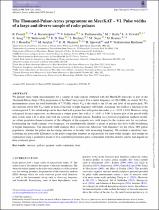| dc.contributor.author | Posselt, B | |
| dc.contributor.author | Karastergiou, A | |
| dc.contributor.author | Serylak, M | |
| dc.date.accessioned | 2022-06-20T07:30:45Z | |
| dc.date.available | 2022-06-20T07:30:45Z | |
| dc.date.issued | 2022 | |
| dc.identifier.citation | Posselt, B., Karastergiou, A., Johnston, S., Parthasarathy, A., Keith, M. J., Oswald, L. S., . . . Venkatraman Krishnan, V. (2021). The thousand-pulsar-array programme on MeerKAT - VI. pulse widths of a large and diverse sample of radio pulsars. Monthly Notices of the Royal Astronomical Society, 508(3), 4249-4268. doi:10.1093/mnras/stab2775 | en_US |
| dc.identifier.issn | doi:10.1093/mnras/stab2775 | |
| dc.identifier.uri | http://hdl.handle.net/10566/7521 | |
| dc.description.abstract | We present pulse width measurements for a sample of radio pulsars observed with the MeerKAT telescope as part of the Thousand-Pulsar-Array (TPA) programme in the MeerTime project. For a centre frequency of 1284 MHz, we obtain 762 W10 measurements across the total bandwidth of 775 MHz, where W10 is the width at the 10 per cent level of the pulse peak. We also measure about 400 W10 values in each of the four or eight frequency sub-bands. Assuming, the width is a function of the rotation period P, this relationship can be described with a power law with power law index μ = -0.29 ± 0.03. However, using orthogonal distance regression, we determine a steeper power law with μ = -0.63 ± 0.06. A density plot of the period-width data reveals such a fit to align well with the contours of highest density. Building on a previous population synthesis model, we obtain population-based estimates of the obliquity of the magnetic axis with respect to the rotation axis for our pulsars. Investigating the width changes over frequency, we unambiguously identify a group of pulsars that have width broadening at higher frequencies. The measured width changes show a monotonic behaviour with frequency for the whole TPA pulsar population, whether the pulses are becoming narrower or broader with increasing frequency. We exclude a sensitivity bias, scattering and noticeable differences in the pulse component numbers as explanations for these width changes, and attempt an explanation using a qualitative model of five contributing Gaussian pulse components with flux density spectra that depend on their rotational phase. | en_US |
| dc.language.iso | en | en_US |
| dc.publisher | Oxford | en_US |
| dc.subject | Pulsars: general | en_US |
| dc.subject | Radio continuum: stars | en_US |
| dc.subject | Surveys | en_US |
| dc.title | The thousand-Pulsar-Array programme on MeerKAT - VI. Pulse widths of a large and diverse sample of radio pulsars | en_US |
| dc.type | Article | en_US |

